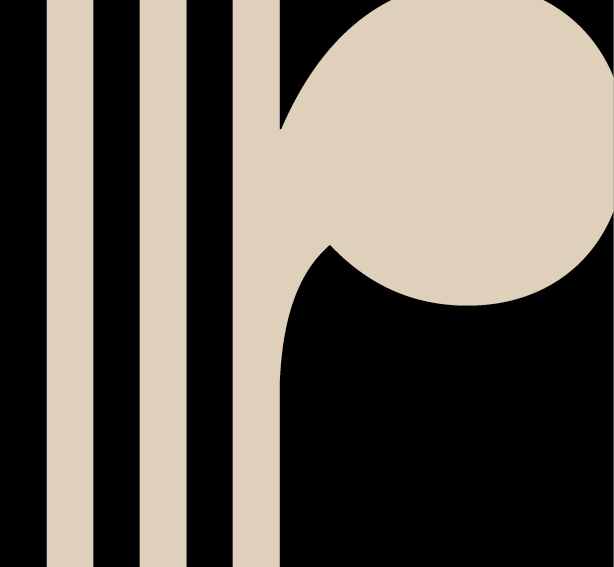01
the problem with waste is not its existance, but why it is labeled as such. while for centuries cities were built on the ruins of lost cultures with their remains and everything was reused, especially in times of crisis, this is still the case today in those regions of the world where poverty has the greatest impact on people. composting in the garden is not an invention of the 20th century, but recycling is. in a society in which the rotational new acquisition of not only unnecessary goods has been perfected, the now unwanted yesterday is ready for collection on the street.
quietly admonishing currents are sweeping the country and the term upcycling is on everyone’s lips long after isabell kerkermeier made her first exploratory foray into the garbage heaps of others to create something new. while our contemporaries give the time-worn object a new shine by returning it to its original function or even to others, kerkermeier does exactly the opposite. instead of stuffing the old sock, her feverish desire to uncover the core of the thing penetrates deep into her finds, only to break them down even further into their component parts.
02
as much as the act of construction through destruction is already applied, the artist achieves her very special signature in the industrious picking apart of discarded objects. the term industrious stands here quite deliberately in contrast to the furious power of a chamberlain but also to the tiredly blinking indifference of every duchampian objet trouvé. kerkermeier’s process draws creative parallels to the ant-like removal in layers, in which the half-dismantled object in its unintentional intermediate phase allows free associations both in form and function.
in that kerkermeier’s works precisely reflect the moment of ’no longer quite there, but not yet gone‘, the concepts of naming and function melt away under her working hands. precisely because she senses the perfect moment of pausing and being finished, time and its progress are stuck here. frankly speaking, this conclusion, the completion of a thing, naturally applies to everything. on the other hand, few artists manage to hit the black in the dark with such precision.
03
notably, it was not until in 2010 that the sculptor began to follow the ants’ footsteps, switching from an additive to a subtractive working method. by first hesitantly and then more and more heartily beginning to pull the strings of her found ingredients, she supposedly reduces the found, large-scale advertising banners to her own artistic visions. in truth, however, she begins to subtly sharpen the pencil from both sides. even if michelangelo’s david was once hewn from a stone, its original form is irrelevant. kerkermeier, on the other hand, plays with the traces of the original, only to smugly let the tassels of forensics dangle in a vacuum.
she skillfully puts a mirror on the nose of her own earlier artistic discoveries. her nylon-stockinged, sports-studio-infiltrated universe of the nineties is stripped of its hair piece by piece until the final bald head, the initial and final image of human appearance, completely dominates the picture surface. naked in appearance, shaggy, stale fluff, a tragedy. isabel kerkermeier loves to laugh and we are certain of one thing – no, she is not laughing at us. whoever laughs last is not necessarily the best storyteller, but simply the joker.
martin eugen raabenstein, 2023
isabel kerkermeier
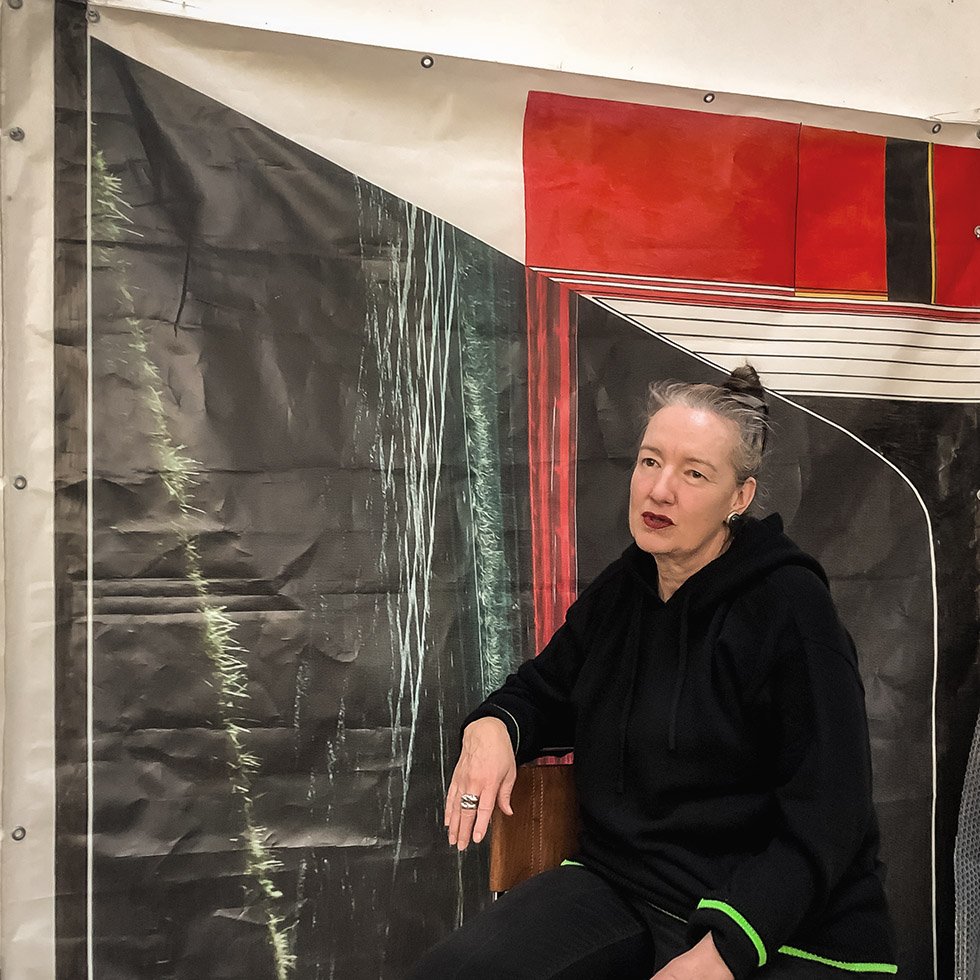

isabel kerkermeier
twoface, 280 x 220 x 10 cm
modified ad banner, plastic, 2019
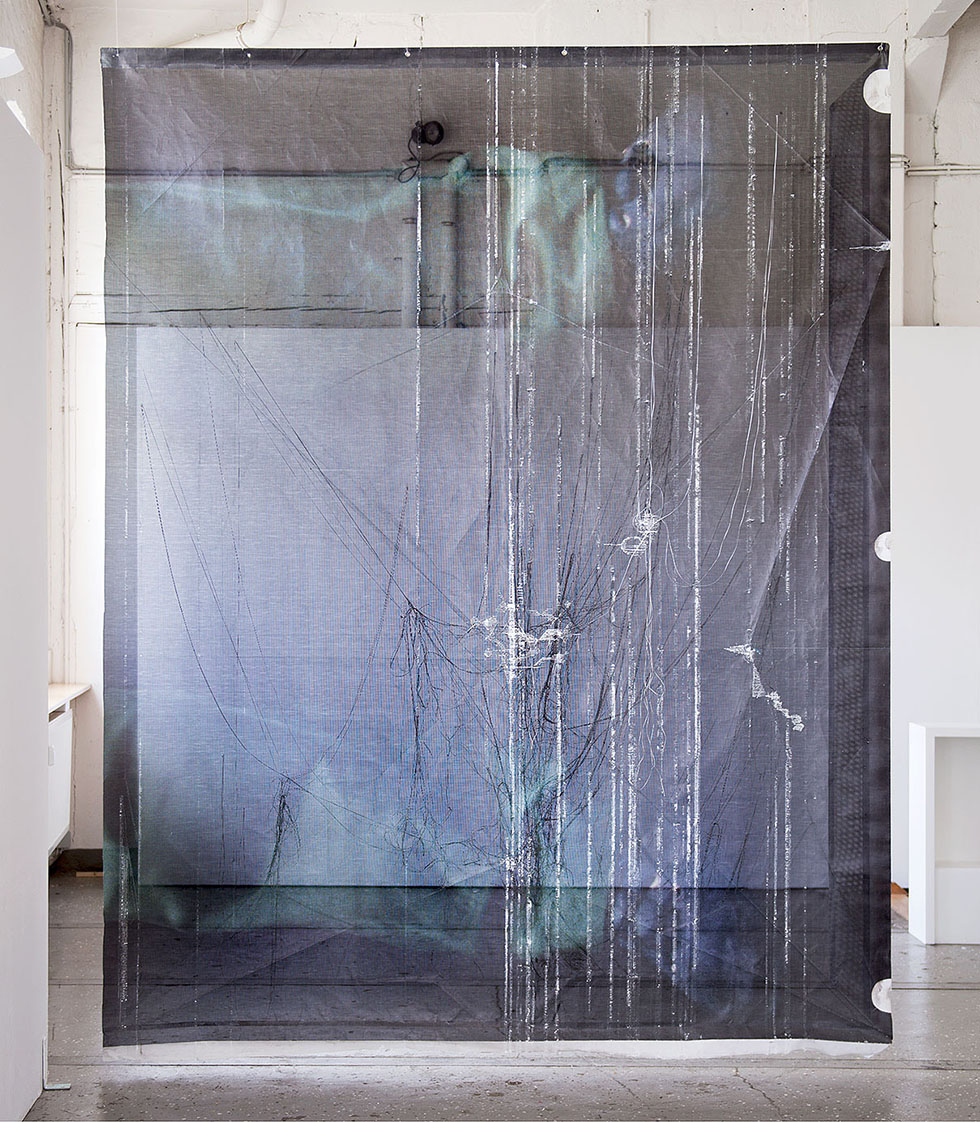
isabel kerkermeier
auf zwei beinen, 310 x 244 x 10 cm
modified ad banner, plastic, 2015
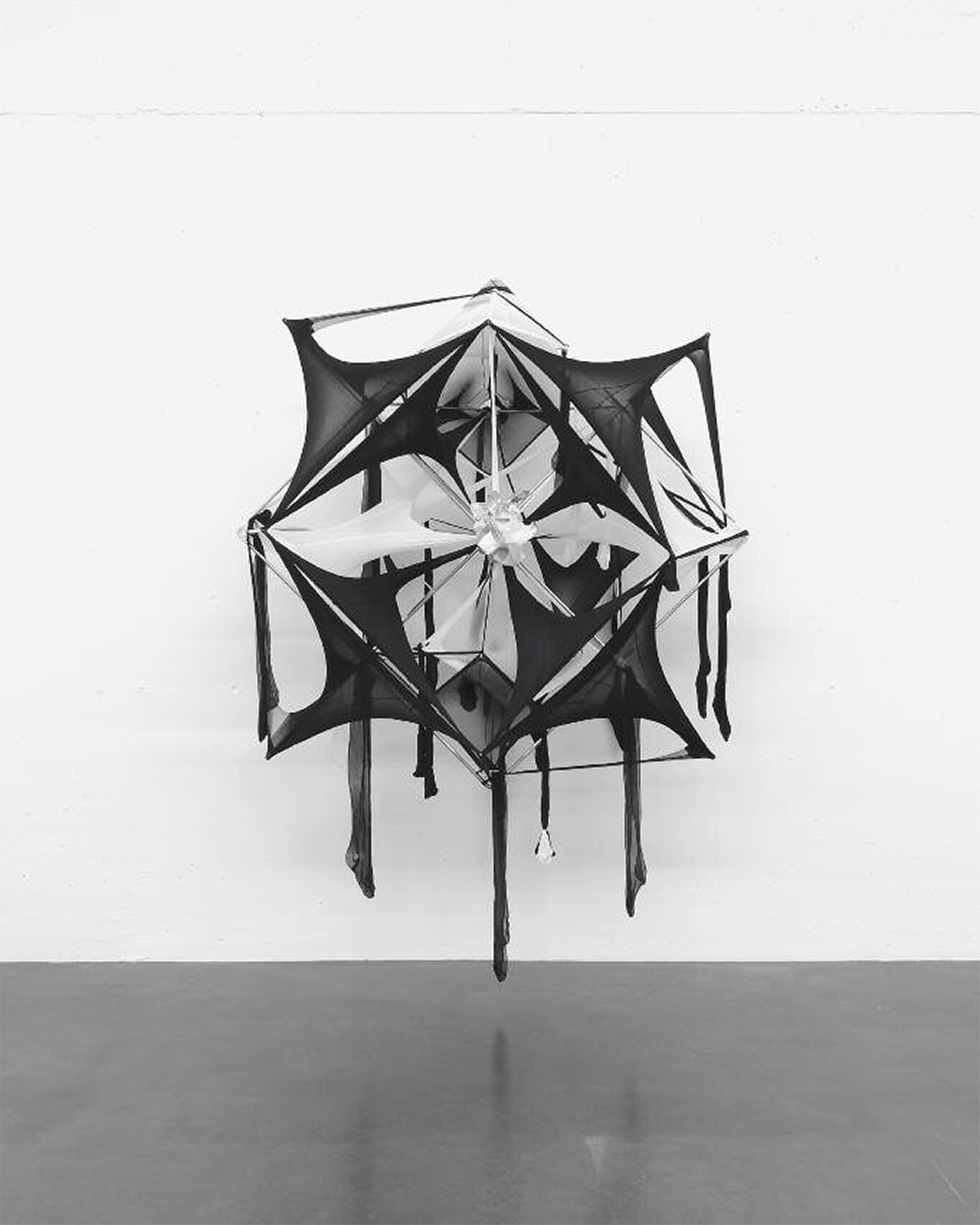
isabel kerkermeier
heritable change, 180 x 145 x 62 cm
chrome-plated tubular steel, nylon, tin, 2011

isabel kerkermeier
equilibrium, 85 x 260 x 130 cm
chrome-plated tubular steel, nylon, modelling clay, expander, plastic, 2009
isabel kerkermeier
01
the problem with waste is not its existance, but why it is labeled as such. while for centuries cities were built on the ruins of lost cultures with their remains and everything was reused, especially in times of crisis, this is still the case today in those regions of the world where poverty has the greatest impact on people. composting in the garden is not an invention of the 20th century, but recycling is. in a society in which the rotational new acquisition of not only unnecessary goods has been perfected, the now unwanted yesterday is ready for collection on the street.
quietly admonishing currents are sweeping the country and the term upcycling is on everyone’s lips long after isabell kerkermeier made her first exploratory foray into the garbage heaps of others to create something new. while our contemporaries give the time-worn object a new shine by returning it to its original function or even to others, kerkermeier does exactly the opposite. instead of stuffing the old sock, her feverish desire to uncover the core of the thing penetrates deep into her finds, only to break them down even further into their component parts.
02
as much as the act of construction through destruction is already applied, the artist achieves her very special signature in the industrious picking apart of discarded objects. the term industrious stands here quite deliberately in contrast to the furious power of a chamberlain but also to the tiredly blinking indifference of every duchampian objet trouvé. kerkermeier’s process draws creative parallels to the ant-like removal in layers, in which the half-dismantled object in its unintentional intermediate phase allows free associations both in form and function.
in that kerkermeier’s works precisely reflect the moment of ’no longer quite there, but not yet gone‘, the concepts of naming and function melt away under her working hands. precisely because she senses the perfect moment of pausing and being finished, time and its progress are stuck here. frankly speaking, this conclusion, the completion of a thing, naturally applies to everything. on the other hand, few artists manage to hit the black in the dark with such precision.
03
notably, it was not until in 2010 that the sculptor began to follow the ants’ footsteps, switching from an additive to a subtractive working method. by first hesitantly and then more and more heartily beginning to pull the strings of her found ingredients, she supposedly reduces the found, large-scale advertising banners to her own artistic visions. in truth, however, she begins to subtly sharpen the pencil from both sides. even if michelangelo’s david was once hewn from a stone, its original form is irrelevant. kerkermeier, on the other hand, plays with the traces of the original, only to smugly let the tassels of forensics dangle in a vacuum.
she skillfully puts a mirror on the nose of her own earlier artistic discoveries. her nylon-stockinged, sports-studio-infiltrated universe of the nineties is stripped of its hair piece by piece until the final bald head, the initial and final image of human appearance, completely dominates the picture surface. naked in appearance, shaggy, stale fluff, a tragedy. isabel kerkermeier loves to laugh and we are certain of one thing – no, she is not laughing at us. whoever laughs last is not necessarily the best storyteller, but simply the joker.
martin eugen raabenstein, 2023
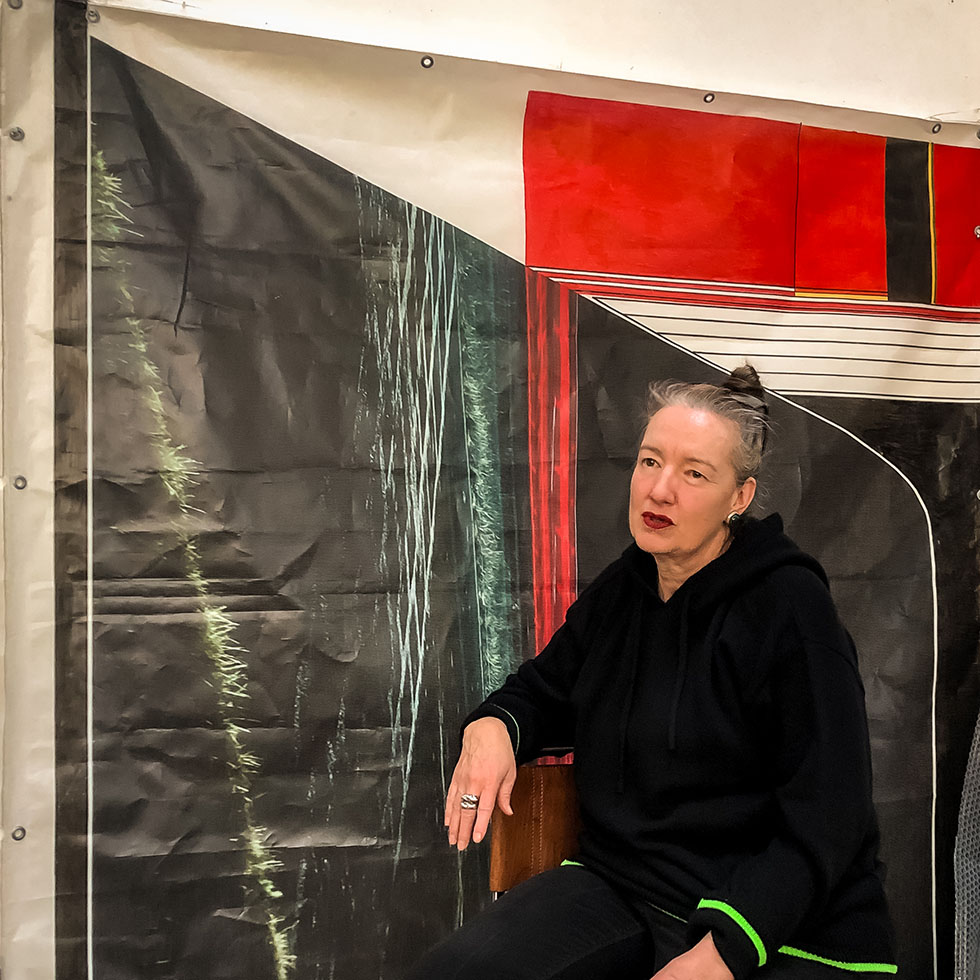
isabel kerkermeier

isabel kerkermeier
auf zwei beinen, 310 x 244 x 10 cm
modified ad banner, plastic, 2015

isabel kerkermeier
twoface, 280 x 220 x 10 cm
modified ad banner, plastic, 2019

isabel kerkermeier
heritable change, 180 x 145 x 62 cm
chrome-plated tubular steel, nylon, tin, 2011

isabel kerkermeier
equilibrium, 85 x 260 x 130 cm
chrome-plated tubular steel, nylon, modelling clay, expander, plastic, 2009
